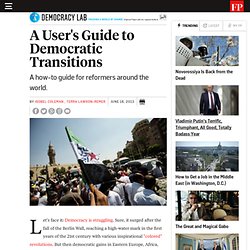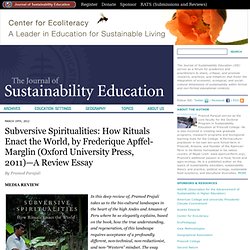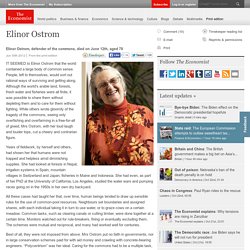

How to Find the Poor - India Real Time. Ited Nations Millennium Development Goals. The eight Millennium Development Goals (MDGs) – which range from halving extreme poverty rates to halting the spread of HIV/AIDS and providing universal primary education, all by the target date of 2015 – form a blueprint agreed to by all the world’s countries and all the world’s leading development institutions.

They have galvanized unprecedented efforts to meet the needs of the world’s poorest. The UN is also working with governments, civil society and other partners to build on the momentum generated by the MDGs and carry on with an ambitious post-2015 development agenda. News on Millennium Development Goals. Well-timed-nudge. What to Consider When You Are Considering Donating. As part of The World’s investigative project Tracking Charity, we recently held an online chat with experts in the realm of giving.

Our question: How do you know a good charity when you see it? Seriously, this is a hard question! Discussion: How Do You Know a Good #Charity When You See It? #Int #Aid — Hailey Kim (@nirvanahy) August 21, 2013 It's not an easy question to answer, particularly when you are focusing on organizations that work in developing countries while securing donations from people in the United States. So, how do you know a good charity when you see it? Here’s one tip: Look at a charity’s website and marketing materials.
“They should never be represented as tragic victims or simply as happy, passive recipients of Western aid,” says Cecelia Lynch, a blogger and professor of political science at the University of California, Irvine. Dayna Brown, from a Massachusetts-based nonprofit (CDA) that works to improve international aid, agrees. A User's Guide to Democratic Transitions. Let's face it: Democracy is struggling.

Sure, it surged after the fall of the Berlin Wall, reaching a high-water mark in the first years of the 21st century with various inspirational "colored" revolutions. But then democratic gains in Eastern Europe, Africa, and Latin America stalled, or even deteriorated, as fragile democracies struggled under the enormous challenge of governance. The expensive U.S. failures to impose democracy in Iraq and Afghanistan haven't helped.
Today, many countries that once seemed budding with democratic promise now appear mired in political infighting, beset by power grabs by ousted elites, or trapped in downward spirals of poverty and unemployment. And the seemingly inexorable rise of autocratic China, in sharp contrast with gridlocked western democracies, has some wondering whether democracy is even worth pursuing. The hard truth, however, is that the transition from authoritarianism to democracy is notoriously difficult. 1. 2. 3. Consider these examples: Yochai Benkler: The new open-source economics. Lenispot Digital Learning Styles. Tania Singer on the merits of teaching compassion over competition. Changetheworld/The Penguin and the Leviathan Ch 1, 10.
Lewis Hyde, author of Common as Air: Revolution, Art, and Ownership. Mike Linksvayer, August 27th, 2010 Poet and scholar Lewis Hyde has been writing about the commons for over thirty years. The Tragedy of the Commons. Garrett Hardin + Author Affiliations Abstract The population problem has no technical solution; it requires a fundamental extension in morality.

At the end of a thoughtful article on the future of nuclear war, Wiesner and York (1) concluded that: "Both sides in the arms race are ...confronted by the dilemma of steadily increasing military power and steadily decreasing national security. It is our considered professional judgment that this dilemma has no technical solution. I would like to focus your attention not on the subject of the article (national security in a nuclear world) but on the kind of conclusion they reached, namely that there is no technical solution to the problem. In our day (though not in earlier times) technical solutions are always welcome.
It is easy to show that the class is not a null class. The class of "No technical solution problems" has members. What Shall We Maximize? No--for two reasons, each sufficient by itself. Man must imitate this process. Pollution In C. Barry Chernoff Discusses COE, Darwin, and Climate - Features - The Wesleyan Argus. Chair of the Environmental Studies Program and Director of the College of the Environment Barry Chernoff is really into folk music and Harry Potter.

Perhaps more importantly, he specializes in ecology, the evolution and biogeography of freshwater fishes, morphological evolution, and the conservation of aquatic ecosystems. The ponytailed Chernoff sat down with The Argus to discuss detective novels, poetry, and next year’s College of the Environment think tank. He also answered the question that’s been on everyone’s mind: what is up with the weather? Www.centrosachamama.org. Sachamama Center for BioCultural Regeneration (SCBR) is a non-profit organization in the Peruvian High Amazon in the town of Lamas, Department of San Martin, dedicated to the biocultural regeneration of the region in collaboration with the indigenous Kichwa-Lamistas, the descendants of pre-Columbian inhabitants, as well as with the local Education Board of the district of Lamas (Sp. acronym UGEL).

SCBR was founded in 2009 by the anthropologist Frédérique Apffel-Marglin. Subversive Spiritualities: How Rituals Enact the World, by Frederique Apffel-Marglin (Oxford University Press, 2011)—A Review Essay « Journal of Sustainability Education. March 19th, 2012By Pramod Parajuli In this deep review of , Pramod Prajuli takes us to the bio-cultural landscapes in the heart of the high Andes and Amazon of Peru where he so elegantly explains, based on the book, how the true understanding, and regeneration, of this landscape requires acceptance of a profoundly different, non-technical, non-reductionist, and non-“Western” mindset.

The esay illustrates residue of enchanted bio-cultural patrimony, as it still survives and thrives in the Peruvian highlands as well as in the High Amazon. The core message of the book is to show that this patrimony is not a one-way street where the humans enact on nature but rather a two-way street where nature also enacts upon members of human species. Elinor Ostrom. IT SEEMED to Elinor Ostrom that the world contained a large body of common sense.

People, left to themselves, would sort out rational ways of surviving and getting along. Although the world's arable land, forests, fresh water and fisheries were all finite, it was possible to share them without depleting them and to care for them without fighting. While others wrote gloomily of the tragedy of the commons, seeing only overfishing and overfarming in a free-for-all of greed, Mrs Ostrom, with her loud laugh and louder tops, cut a cheery and contrarian figure. Years of fieldwork, by herself and others, had shown her that humans were not trapped and helpless amid diminishing supplies. She had looked at forests in Nepal, irrigation systems in Spain, mountain villages in Switzerland and Japan, fisheries in Maine and Indonesia.
All these cases had taught her that, over time, human beings tended to draw up sensible rules for the use of common-pool resources. Elinor Ostrom. Elinor "Lin" Ostrom (born Elinor Claire Awan;[2] August 7, 1933 – June 12, 2012) was an American political economist[3][4][5] whose work was associated with the New Institutional Economics and the resurgence of political economy.[6] In 2009, she shared the Nobel Memorial Prize in Economic Sciences with Oliver E.

Williamson for "her analysis of economic governance, especially the commons".[7] To date, she remains the only woman so honored. Ostrom lived in Bloomington, Indiana and served on the faculty of both Indiana University and Arizona State University. She held the rank of Distinguished Professor at Indiana University and was the Arthur F.